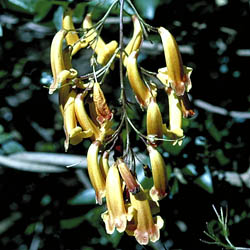Pandorea 'Golden Showers'
 |
Also written as Pandorea pandorana 'Golden Showers'
Pandorea pandorana 'Golden Showers' nom. cult.
Pandorea pandorana, the Wonga-wonga vine, is a member of the Bignoniaceae family. It is a vigorous woody climber found over an extensive area of eastern Australia in many differing environments. While more usually associated with moist forest habitats, it is also found in sandy soils close to the coast, in richer loams of volcanic origin, rocky situations in drier areas, and rainforest verges. It is often a persistent species in disturbed or cleared areas.
In forest conditions the plant may be difficult to see. It grows rapidly into the canopy and quite often the only indication of its presence will be liana vines reaching into the canopy and, during spring, the fallen flowers littering the forest floor. In more open forests it is a prominent species scrambling through the undershrubs. The leaves are easily distinguished, being pinnate and very glossy. An individual leaf consists of from five to nine leaflets that are ovate in shape and from 7 to 8 cm long.
In spring the massed tubular flowers are very conspicuous. They can vary from white or cream to brown and often have maroon or purple striations in the throat of each blossom.
Seed is formed in a pod-like capsule from 4 to 7 cm long. The capsule opens to reveal copious quantities of flattened seeds, each one with a membranous, encircling 'wing'.
The original selection of Pandorea 'Golden Showers' was made by the Australian National Botanic Gardens from a naturally occurring plant of Pandorea pandorana growing near Kempsey in New South Wales in 1967. The cultivar name 'Golden Showers' refers to the golden-brown pendulous inflorescences. This cultivar will tolerate light frosts but could not be regarded as frost-hardy. If grown in cold environments it would require some protection, either by careful siting in protected positions near buildings or under a protecting plant canopy. It would be difficult to establish in 'frost hollows' where cold winter air has a tendency to pool.
The seeds of this cultivar germinate freely and many adventitious seedlings have appeared at the Gardens. Although plants can be raised from seed, this form of propagation will not guarantee flower colour. To retain the characteristics of 'Golden Showers', or for that matter any other desired colour form, vegetative propagation must be used. Tip cuttings of medium-wood material are suitable. Though found naturally in a wide range of environments, cultivation at the Gardens has shown that Pandorea 'Golden Showers', like other forms of the species, performs best in richer soils with some year-round moisture. Soils should not dry out nor should the plants be subjected to extensive soil moisture fluctuations. Plants develop to their full potential in semi-shaded situations. It is an excellent species to use on fences, pergolas or trellises. If desired for use as a climber on trees, some care must be exercised due to the constrictive liana habit as this may inhibit or strangle younger trees as they develop.
Pandorea 'Golden Showers' has proved to be pest free at the Australian National Botanic Gardens.
Text by Geoff Butler, ANBG (1986)
Name meaning: Pandorea pandoranaPandorea - relating to the legend of Pandora's box, of which Spach (the author of the name) is said to have been reminded by the fruits. Another suggestion is that the original species was connected with a plague of insects on Norfolk Island; pandorana - from Pandora and the Latin suffix, - ana, relating to. 'Golden Showers' - refers to the golden-brown pendulous inflorescences |
![An Australian Government Initiative [logo]](/images/austgovt_brown_90px.gif)

